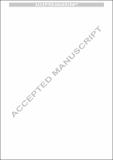Por favor, use este identificador para citar o enlazar a este item:
http://hdl.handle.net/10261/192579COMPARTIR / EXPORTAR:
 SHARE SHARE
 CORE
BASE CORE
BASE
|
|
| Visualizar otros formatos: MARC | Dublin Core | RDF | ORE | MODS | METS | DIDL | DATACITE | |

| Título: | Selection of reliable reference genes for RT-qPCR studies in Octopus vulgaris paralarvae during development and immune-stimulation |
Autor: | García-Fernández, Pablo; Castellanos-Martínez, Sheila CSIC; Iglesias, José; Otero, Juan José; Gestal, C. CSIC ORCID | Palabras clave: | Octopus vulgaris Paralarvae Reference gene RT-qPCR Development Infection |
Fecha de publicación: | 2016 | Editor: | Elsevier | Citación: | Journal of Invertebrate Pathology 138: 57-62 (2016) | Resumen: | The common octopus, Octopus vulgaris is a new candidate species for aquaculture. However, rearing of octopus paralarvae is hampered by high mortality and poor growth rates that impede its entire culture. The study of genes involved in the octopus development and immune response capability could help to understand the key of paralarvae survival and thus, to complete the octopus life cycle. Quantitative real-time PCR (RT-qPCR) is the most frequently tool used to quantify the gene expression because of specificity and sensitivity. However, reliability of RT-qPCR requires the selection of appropriate normalization genes whose expression must be stable across the different experimental conditions of the study. Hence, the aim of the present work is to evaluate the stability of six candidate genes: β-actin (ACT), elongation factor 1-α (EF), ubiquitin (UBI), β-tubulin (TUB), glyceraldehyde 3-phosphate dehydrogenase (GADPH) and ribosomal RNA 18 (18S) in order to select the best reference gene. The stability of gene expression was analyzed using geNorm, NormFinder and Bestkeeper, in octopus paralarvae of seven developmental stages (embryo, paralarvae of 0, 10, 15, 20, 30 and 34 days) and paralarvae of 20 days after challenge with Vibrio lentus and Vibrio splendidus. The results were validated by measuring the expression of PGRP, a stimuli-specific gene. Our results showed UBI, EF and 18S as the most suitable reference genes during development of octopus paralarvae, and UBI, ACT and 18S for bacterial infection. These results provide a basis for further studies exploring molecular mechanism of their development and innate immune defense | Descripción: | 6 pages, 3 figures, 2 tables | Versión del editor: | https://doi.org/10.1016/j.jip.2016.06.003 | URI: | http://hdl.handle.net/10261/192579 | DOI: | 10.1016/j.jip.2016.06.003 | ISSN: | 0022-2011 | E-ISSN: | 1096-0805 |
| Aparece en las colecciones: | (IIM) Artículos |
Ficheros en este ítem:
| Fichero | Descripción | Tamaño | Formato | |
|---|---|---|---|---|
| Selected_reliable_reference_2016.pdf | 525,42 kB | Adobe PDF |  Visualizar/Abrir |
CORE Recommender
SCOPUSTM
Citations
14
checked on 25-mar-2024
WEB OF SCIENCETM
Citations
13
checked on 21-feb-2024
Page view(s)
244
checked on 18-abr-2024
Download(s)
360
checked on 18-abr-2024
Google ScholarTM
Check
Altmetric
Altmetric
NOTA: Los ítems de Digital.CSIC están protegidos por copyright, con todos los derechos reservados, a menos que se indique lo contrario.
